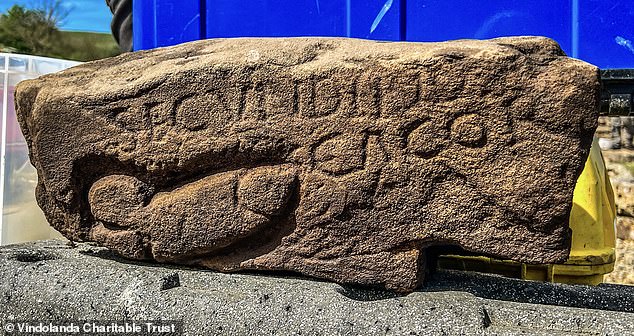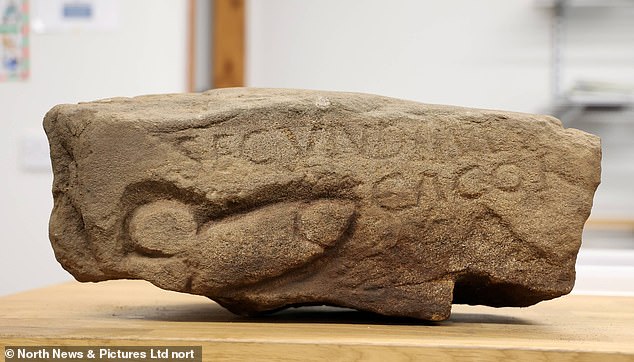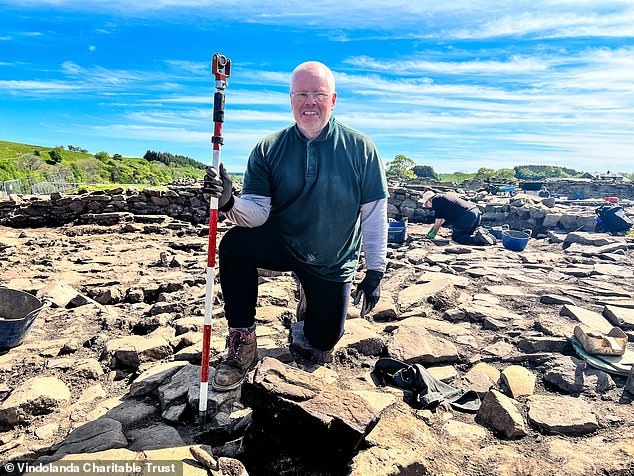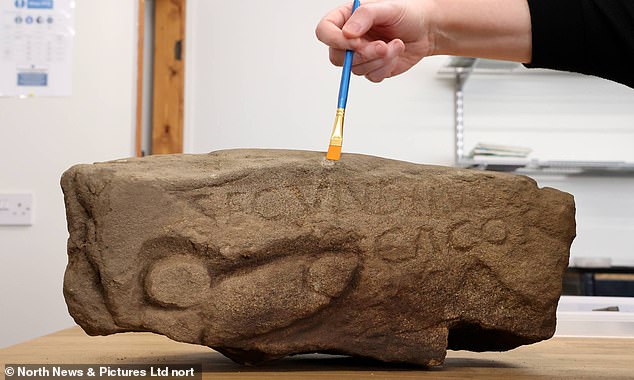'Secundinus, the s***ter': 1,700-year-old graffiti is found on Hadrian's Wall featuring a large phallus and an insult aimed at another Roman soldier
The graffiti was found at Vindolanda, a Roman fort in NorthumberlandThe stone features a carving of a phallus measuring 15.7 x 6 inches
Also features SECVNDINVS CACOR, which translates to Secundinus, the s***ter
By SHIVALI BEST FOR MAILONLINE
26 May 2022
In most classrooms across the UK, it's likely you'll find rude graffiti scrawled on the desks.
Now, a new discovery at Hadrian's Wall suggests these types of cheeky scribblings date back thousands of years.
Researchers have discovered a large phallus and an inscription which brands a Roman soldier called Secundinus a 's***ter' at the historic site, dating back 1,700 years.
'Its author clearly had a big problem with Secundinus and was confident enough to announce their thoughts publicly on a stone,' said Dr Andrew Birley, Director of Excavations and CEO of the Vindolanda Trust.
'I have no doubt that Secundinus would have been less than amused to see this when he was wandering around the site over 1,700 years ago.'

Researchers have discovered a large phallus and an inscription which brands a Roman soldier called Secundinus a 's***ter' at the historic site, dating back 1,700 years
The phallus: An image of strength and virility
Phallic emblems are found on a wide range of Roman objects, from amulets to frescoes to mosaics to lamps.They were symbols intended to bring good luck and ward off evil spirits.
As the ancient author Pliny attests, even babies and soldiers wore such charms to invite divine protection.
Source: Met Museum
The graffiti was uncovered at Vindolanda, a picturesque fort and settlement in the Northumberland countryside, which is part of the Hadrian's Wall World Heritage Site.
'It comes from a secure context below a 4th century cavalry barracks, discarded into a long trench filled with rubble,' a spokesperson said.
This isn't the first time quirky scribbling have been found at Vindolanda – previously, archaeologists found a handwritten birthday invitation where one woman invited her 'dearest sister' to join her.
The latest discovery was made by Dylan Herbert, a retired biochemist from South Wales, who was volunteering with the Vindolanda Trust.
'I'd been removing a lot of rubble all week and to be honest this stone had been getting in my way, I was glad when I was told I could take it out of the trench,' Mr Herbert said.
'It looked from the back like all the others, a very ordinary stone, but when I turned it over, I was startled to see some clear letters.
'Only after we removed the mud did I realise the full extent of what I'd uncovered, and I was absolutely delighted.'

The stone features a phallus measuring 15.7 x 6 inches, along with the words SECVNDINVS CACOR

The latest discovery was made by Dylan Herbert (pictured with his discovery), a retired biochemist from South Wales, who was volunteering with the Vindolanda Trust
The stone features a carving of a phallus measuring 15.7 x 6 inches, along with the words SECVNDINVS CACOR.
Dr Alexander Meyer, Dr Alex Mullen and Dr Roger Tomlin, specialists in Roman epigraphy, recognised these words as a mangled version of 'Secundinus cacator'.
This translates to 'Secundinus, the s***ter', according to the experts.
'The recovery of an inscription, a direct message from the past, is always a great event on a Roman excavation, but this one really raised our eyebrows when we deciphered the message on the stone,' Dr Birley said.

Dr Alexander Meyer, Dr Alex Mullen and Dr Roger Tomlin, specialists in Roman epigraphy, recognised these words as a mangled version of 'Secundinus cacator'. This translates to 'Secundinus, the s***ter', according to the experts

Engraving of phalluses are not uncommon on Hadrian's Wall, with a total of 13 now found at the historic site
Engraving of phalluses are not uncommon on Hadrian's Wall, with a total of 13 now found at the historic site.
While the symbol is usually seen as an image of strength and virility, that's likely not the case with this new finding.
In this case, the author has 'cleverly taken its meaning and subverted it to their own aims,' according to the researchers.
'This fabulous bit of social commentary from the ancient past will amuse visitors for many years to come,' they said in a release.
'It reminds us that while the Roman army could be extremely brutal, especially to the native population, they were not immune to hurling insults at each other.'
WHAT IS VINDOLANDA AND WHAT WAS ITS ROLE IN ROMAN BRITAIN?
Vindolanda is a Roman fort south of Hadrian's Wall in northern England.Soldiers stationed there guarded the Roman road from the River Tyne to Solway Firth.
Wooden tablets were discovered there which are considered the most important examples of military and private correspondence found anywhere in the Roman Empire.
The garrison was home to auxiliary infantry and cavalry units - not parts of Roman legions.

Vindolanda (pictured) is a Roman fort south of Hadrian's Wall in northern England
Roman boots, shoes, armours, jewellery, coins and tablets have all been found there.
In 2006, a richly-decorated silver brooch featuring the figure of Mars was found.
It belonged to Quintus Sollonius, a Gaul, whose name was inscribed on the brooch.

Vindolanda Roman fort on Hadrians Wall, Northumberland. Soldiers stationed there guarded the Roman road from the River Tyne to Solway Firth
1,700-year-old phallus and inscription branding Roman solider a 's***ter' found at Hadrian's Wall | Daily Mail Online